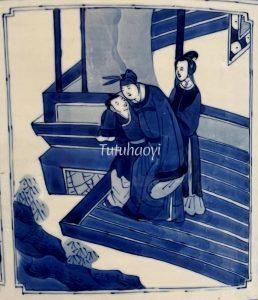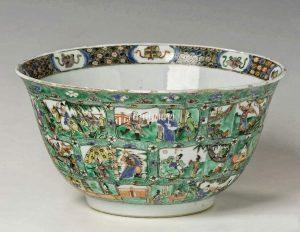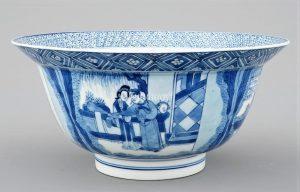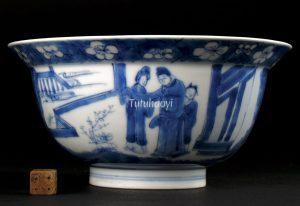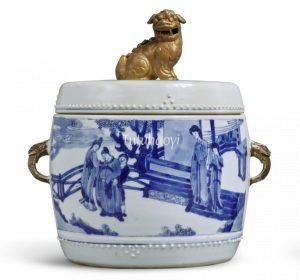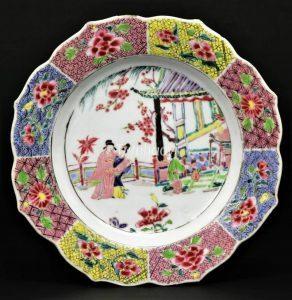Scholar Zhang Getting Drunk Due to Madame Cui’s Broken Promise
张生醉酒 (崔母悔婚)
© Tutuhaoyi.com owns the copyright of the description content for the images attached. Quoting all or part of the description content on this page is permitted ONLY IF ‘Tutuhaoyi.com’ is clearly acknowledged anywhere your quote is produced unless stated otherwise. (本页描述内容版权归Tutuhaoyi.com所有,转发或引用需注明 “Tutuhaoyi.com”, 侵权必究, 已注开源信息的条目除外。)
This is Scene Four of Act Two of the Chinese classic popular drama Romance of the Western Chamber (西厢记 Xixiang Ji), written by the Yuan playwright Wang Shifu (1250–1336).
Madame Cui and her daughter Cui Yingying 崔莺莺 were residing temporarily in the monastery where Zhang Junrui’s (张君瑞, also called Scholar Zhang 张生) happened to stay there as well while he was on his way to the state examination.
A local bandit Sun Feihu 孙飞虎 came for the beautiful Yingying whom Scholar Zhang fell deeply in love with. During the crisis, Madame Cui promised that whoever saved the monastery would be able to marry Yingying. Scholar Zhang asked help from his friend Du Que 杜确 (nicknamed General White Horse 白马将军) who later rescued the monastery successfully.
Madame Cui held a dinner party to thank Scholar Zhang. However, she introduced Zhang to Yingying as ‘your brother’, meaning not to honour her promise. Scholar Zhang felt like being knocked unconscious and had nothing at the dinner except endless cups of wine. He became very drunk and had to be fully supported by his page boy on his way home.
story scene description by Rachel Ma
Other episodes in the Romance of the Western Chamber:
Scholar Zhang Embarking on His Journey to Sit for Civil-Service Examinations 张生赶考
Scholar Zhang renting a room in the monastery 僧房假寓 (禅关假馆)
Scholar Zhang and Cui Yingying exchanging verses in the garden 唱和东墙 (墙角联吟)
Consummation of love from Western Chamber 月下佳期
Fig 1: porcelain dish with underglaze blue decoration, c. 1655–1665, courtesy of the Art Institute of Chicago
Fig 2: porcelain vase with underglaze blue decoration (detail), Kangxi period (1662–1722), Qing dynasty, courtesy of the Victoria & Albert Museum, London, photograph by Mr JP Kim
Fig 3-4: porcelain bowl with overglaze enamelled decoration, Kangxi period (1662–1722), Qing dynasty, courtesy of Groninger Museum, Groningen, The Netherlands
Fig 5-6: porcelain charger of a pair with overglaze enamelled decoration, Kangxi period (1662–1722), Qing dynasty, courtesy of the Munich Residence Museum, photograph by Mr Jason Ooi
Fig 7: porcelain bowl with underglaze blue decoration, Kangxi period (1662–1722), Qing dynasty, courtesy of the Department of History of Art, University of Glasgow
Fig 8: porcelain bowl with underglaze blue decoration, Kangxi period (1662–1722), Qing dynasty, courtesy of the Marc Michot Gallery
Fig 9: porcelain bowl with underglaze blue decoration, Kangxi period (1662–1722), Qing dynasty, courtesy of the Marc Michot Gallery
Fig 10: porcelain bowl with underglaze blue decoration, Kangxi period (1662–1722), Qing dynasty, formerly in the Robert McPherson collection
Fig 11: porcelain jar with underglaze blue decoration, Kangxi period (1662–1722), Qing dynasty, courtesy of the Sotheby’s Auction House, New York, 23 March 2022, No 333.
Fig 12: famille rose porcelain plate, c. 1735, courtesy of Cohen & Cohen collection, Ref No. R02

